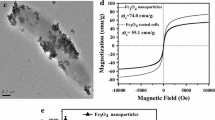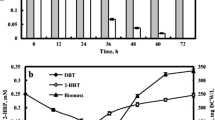Abstract
Objective
Thialkalivibrio versutus D301 cells were immobilized on Fe3O4 nanoparticles (NPs) synthesized by an improved chemical coprecipitation method and modified with 3-aminopropyltriethoxysilane (APTES), then the immobilized cells were used in sulfur oxidation.
Results
The prepared Fe3O4–APTES NPs had a narrow size distribution (10 ± 2 nm) and were superparamagnetic, with a saturation magnetization of 60.69 emu/g. Immobilized cells had a saturation magnetization of 34.95 emu/g and retained superparamagnetism. The optimum conditions for cell immobilization were obtained at pH 9.5 and 1 M Na+. The immobilization capacity of Fe3O4–APTES NPs was 7.15 g DCW/g-NPs that was 2.3-fold higher than that of Fe3O4 NPs. The desulfurization efficiency of the immobilized cells was close to 100%, having the same sulfur oxidation capacity as free cells. Further, the immobilized cells could be reused at least eight times, retaining more than 85% of their desulfurization efficiency.
Conclusion
Immobilization of cells with the modified magnetic NPs efficiently increased cell controllability, have no effect on their desulfurization activity and could be effectively used in large-scale industrial applications.




Similar content being viewed by others
References
Alnaizy R (2008) Economic analysis for wet oxidation processes for the treatment of mixed refinery spent caustic. Environ Prog 27:295–301
Cerff M, Morweiser M, Dillschneider R, Michel A, Menzel K, Posten C (2012) Harvesting fresh water and marine algae by magnetic separation: screening of separation parameters and high gradient magnetic filtration. Bioresour Technol 118:289–295
Janssen AJH, Lens PNL, Stams AJM et al (2009) Application of bacteria involved in the biological sulfur cycle for paper mill effluent purification. Sci Total Environ 407:1333–1343
Ozmen M, Can K, Arslan G, Tor A, Cengeloglu Y, Ersoz M (2010) Adsorption of Cu(II) from aqueous solution by using modified Fe3O4 magnetic nanoparticles. Desalination 254:162–169
Philip L, Deshusses MA (2003) Sulfur dioxide treatment from flue gases using a biotrickling filter-bioreactor system. Environ Sci Technol 37:1978–1982
Rinzema A, Van Lier J, Lettinga G (1988) Sodium inhibition of acetoclastic methanogens in granular sludge from a UASB reactor. Enzyme Microb Technol 10:24–32
Shen X-C, Fang X-Z, Zhou Y-H, Liang H (2004) Synthesis and characterization of 3-aminopropyltriethoxysilane-modified superparamagnetic magnetite nanoparticles. Chem Lett 33:1468–1469
Sorokin DY, Rusanov II, Pimenov NV, Tourova TP, Abbas B, Muyzer G (2010) Sulfidogenesis under extremely haloalkaline conditions in soda lakes of Kulunda Steppe (Altai, Russia). FEMS Microb Ecol 73:278–290
van den Bosch PL, van Beusekom OC, Buisman CJ, Janssen AJ (2007) Sulfide oxidation at halo-alkaline conditions in a fed-batch bioreactor. Biotechnol Bioeng 97:1053–1063
Xu L, Guo C, Wang F, Zheng S, Liu C-Z (2011) A simple and rapid harvesting method for microalgae by in situ magnetic separation. Bioresour Technol 102:10047–10051
Xu X, Cai Y, Song Z et al (2015) Desulfurization of immobilized sulfur-oxidizing bacteria, Thialkalivibrio versutus, by magnetic nanaoparticles under haloalkaliphilic conditions. Biotechnol Lett 37:1631–1635
Yamaura M, Camilo RL, Sampaio LC, Macêdo MA, Nakamura M, Toma HE (2004) Preparation and characterization of (3-aminopropyl)triethoxysilane-coated magnetite nanoparticles. J Magn Magn Mater 279:210–217
Zhou JM, Song ZY, Yan DJ, Liu YL, Yang MH, Cao HB, Xing JM (2014) Performance of a haloalkaliphilic bioreactor under different NO3(−)/SO4(2−) ratios. Bioresour Technol 153:216–222
Supporting information
Supplementary Fig. 1—ATR-FTIR spectra of Fe3O4 NPs and Fe3O4–APTES NPs.
Supplementary Fig. 2—TGA of Fe3O4 NPs and Fe3O4–APTES NPs.
Supplementary Fig. 3—Magnetization curves of Fe3O4 NPs, Fe3O4–APTES NPs and cells immobilized on Fe3O4–APTES NPs.
Supplementary Fig. 4—Effect of Na+ concentration for cells immobilization.
Supplementary Fig. 5—Effect of solution pH for cells immobilization.
Supplementary Fig. 6—Effect of nanoparticles dosage for cells immobilization.
Supplementary Fig. 7—Adsorption isotherms of Thialkalivibrio versutus D301 cells on Fe3O4–APTES NPs fitted with Langmuir and Freundlich model.
Supplementary Fig. 8—Zeta potentials of Fe3O4 NPs, Fe3O4–APTES NPs and Thialkalivibrio versutus D301 cells.
Author information
Authors and Affiliations
Corresponding author
Additional information
Tingzhen Mu and Jixiang Zhao have contributed equally to this work.
Electronic supplementary material
Below is the link to the electronic supplementary material.
Rights and permissions
About this article
Cite this article
Mu, T., Zhao, J., Guan, Y. et al. Desulfurization with Thialkalivibrio versutus immobilized on magnetic nanoparticles modified with 3-aminopropyltriethoxysilane. Biotechnol Lett 39, 865–871 (2017). https://doi.org/10.1007/s10529-017-2317-2
Received:
Accepted:
Published:
Issue Date:
DOI: https://doi.org/10.1007/s10529-017-2317-2




